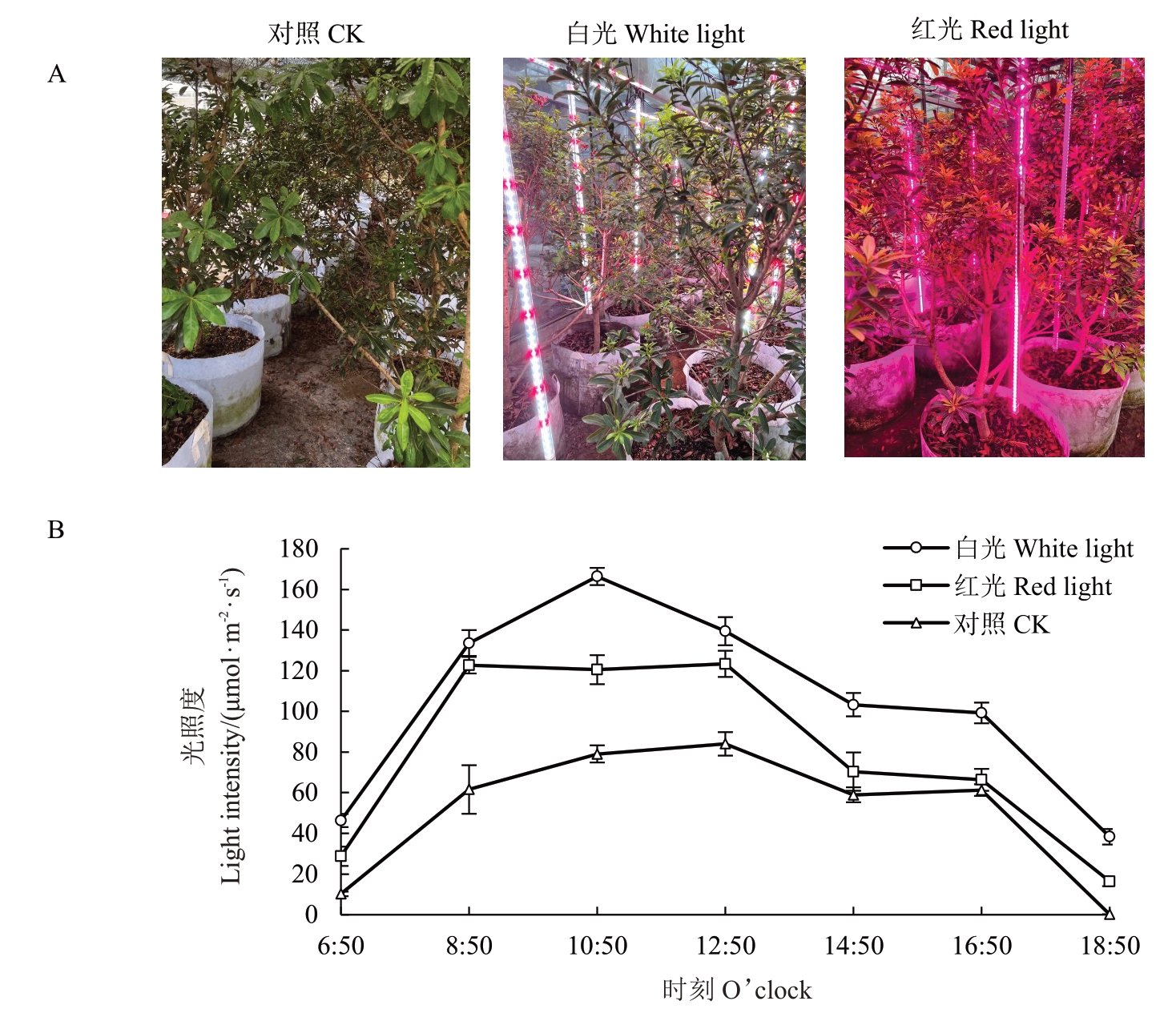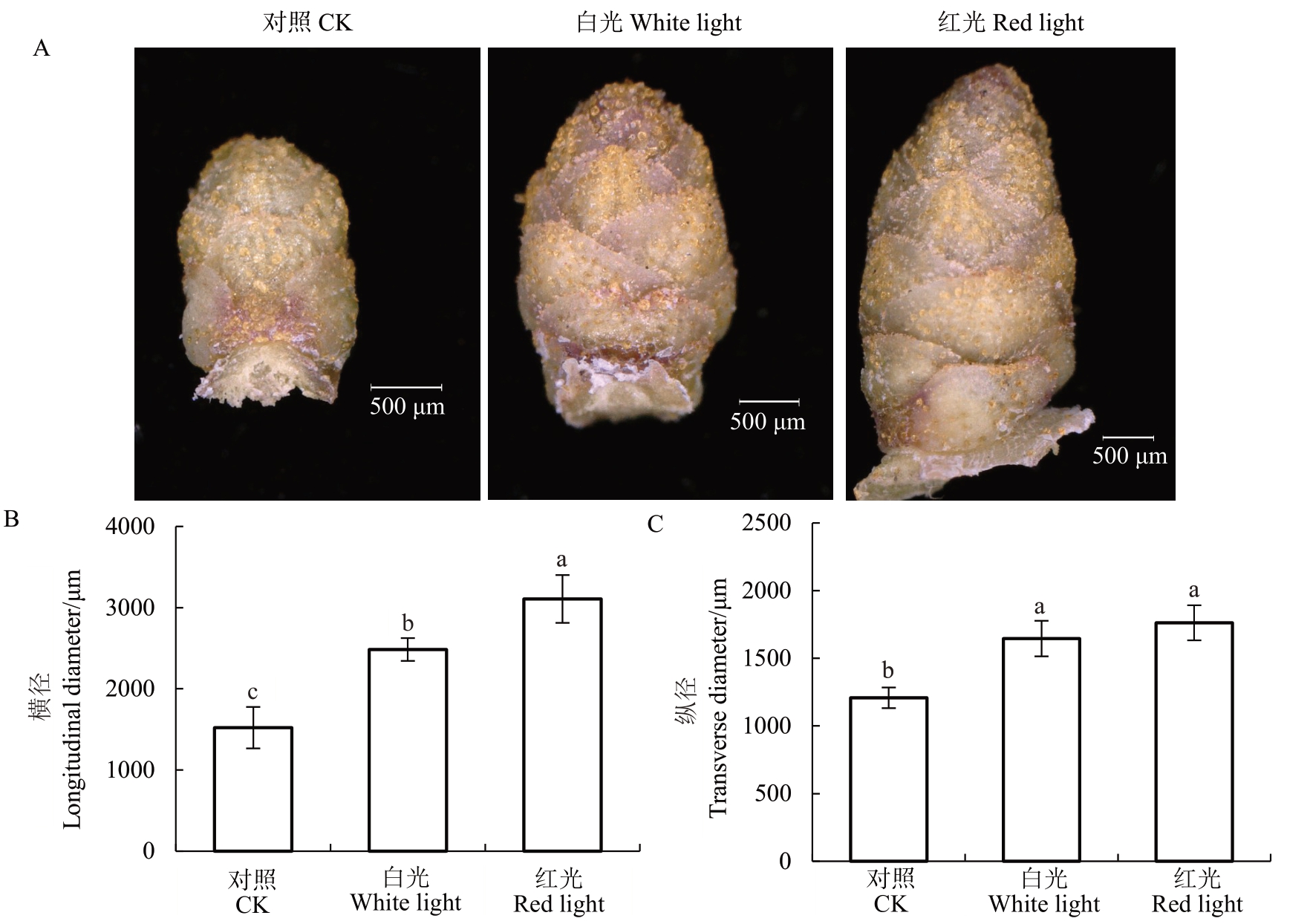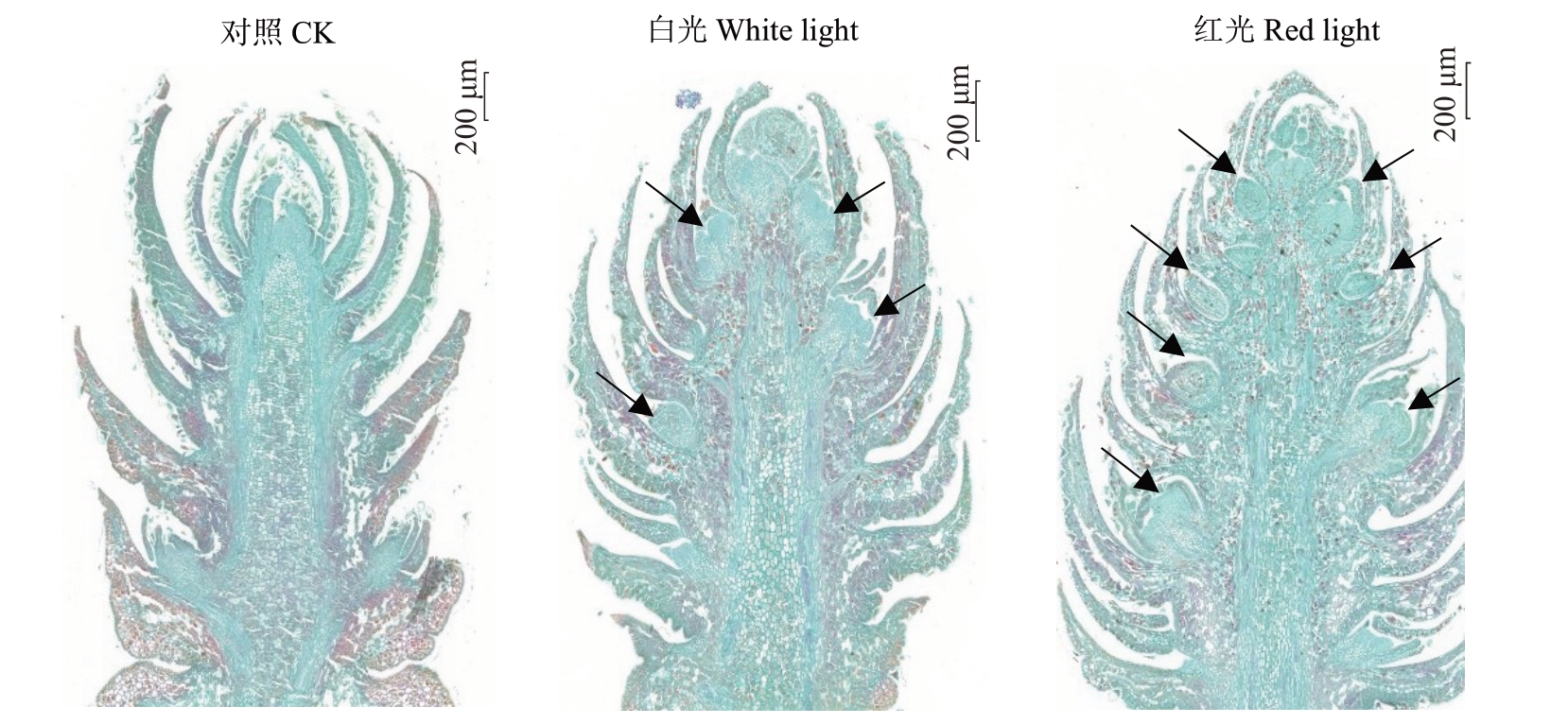杨梅(Myrica rubra Sieb. et Zucc.)为杨梅科杨梅属常绿乔木,是中国的特色果树。杨梅雌雄异株,其中杨梅雌花为葇荑花序,开花时花序由顶端向基部渐次开放[1]。杨梅花芽由顶端的腋芽分化形成,花芽分化期自7 月底开始,至11 月底花芽基本分化完毕,个别延至12 月完成[2],并于翌年2 月初花芽开始进一步萌发膨大,于3 月进入盛花期[3]。每个结果枝上分化的花芽数目受多种因素影响,其中花芽数目较多时可超过25 个,雌花的花芽数目决定了当年雌花花序数目,对杨梅产量有着显著影响[4]。而花芽分化发育过程则与开花质量和果实采收期密切关联,杨梅从花芽分化到花完全盛开需要经历较长时间,因此研究杨梅花芽生长发育过程、探究花芽萌发的影响因素对指导生产有重要意义。
光对植物生长至关重要[5],绝大多数植物的成花过程都受到光照的影响[6]。研究表明,光照度和光质是唐菖蒲花芽发育的决定因素,冬季温室内光照不足时,大部分唐菖蒲花芽败育,开花率极低[7]。蓝光光质有利于菊花花芽分化并提前开花[8]。此外,在远红光下延长光周期,则有利于日本梨花芽分化和发育,使花期提前[9]。植物对不同光质和光照度的响应不同,因此,研究不同波长光对植物成花过程的作用意义重大。
补光是改善光照条件的有效途径[10]。目前研究表明,LED补光可显著促进设施番茄幼苗生长[11],提高西葫芦产量[12],并显著改善越橘的果实品质[13],补光处理也促进了杨梅叶片的生长,降低果实的可滴定酸含量,显著提高了果实糖酸比[14],但有关补光处理对杨梅成花过程的影响未见报道,同时,杨梅花芽的分化和发育过程是否受不同光质的调控也尚不明确。笔者在本研究中通过对设施内杨梅进行不同光质补光处理,分析2种补光灯的光质图谱,研究了不同补光处理下花芽数量、花芽大小和发育情况,探讨了不同光质补光对杨梅花芽生长萌发的影响,为杨梅设施栽培中补光光质的选择及杨梅花期管理调控提供理论依据。
1 材料和方法
1.1 试验材料
试验于浙江省杭州市浙江省农科院试验基地的玻璃温室内进行,供试材料为健康的7 年生荸荠种杨梅盆栽树,单株小区,10次重复,除补光处理不同外,其余设施环境和管理条件相同。
采用白光和红光2种不同光质LED灯,从树顶端和侧方两处进行补光处理,灯管排布方式、补光时间完全一致。以不补光为对照。补光处理从杨梅花芽分化开始(7月),直至开花结束(翌年4月)。每日补光时间从05:00开始,至19:00止,期间分为7个时段(表1),每个时段设定一个光照度的阈值,当光照度不足时自动进行补光。
表1 自动补光的光照度阈值
Table 1 Threshold of light intensity for automatic light supplement

时段Time periods 05:00—07:00 07:00—09:00 09:00—11:00 11:00—13:00 13:00—15:00 15:00—17:00 17:00—19:00光照度阈值Light intensity threshold/(μmol·m-2·s-1)80 160 320 400 320 160 80
1.2 测定方法
1.2.1 光学分析 将2款灯管分别放入光谱测试仪(Haas Suite,EVERFINE)内,持续点亮灯管15 min,等灯具预热稳定后每间隔30 min 测试1 次,测试扫描波长为380~780 nm。色温及光质如图1 显示,并基于光质分析图谱通过MATLAB软件,对不同波长光质参数进行统计分析(表2)。

图1 2 种不同LED 灯的光质分析图谱
Fig.1 Spectral analysis of the two different LED lights used in this study
表2 不同补光灯的光质分析参数
Table 2 Parameters of light quality of two LED lamps

处理Treatment红光/蓝光Red/Blue白光White light红光Red light色温Color temperature/K 3 326.83±24.84 1 556.50±12.41光质组分的比例Ratio of light quality/%400~500 nm蓝光Blue 18.06±0.09 12.21±0.13 500~600 nm绿光Green 28.02±0.18 9.99±0.17 600~700 nm红光Red 47.60±0.19 57.79±0.22 700~780 nm远红光Far-red 5.15±0.08 18.85±0.12 2.64±0.02 4.73±0.04峰值波长Peak wavelength/nm 657.65±0.60 656.52±1.15光合辐照度Photosynthetically active radiation/mW 6 519.87±45.44 5 545.33±190.02
2种LED灯的峰值波长相近,但在色温、光质组分和光合辐照度(植物用于光合作用的光合有效辐射)上存在较大差异。白光LED补光灯峰值波长为657.65 nm,色温为3329 K,其中蓝光和绿光(冷色光)比例较高,红光和远红光(暖色光)比例较低,红蓝光比为2.6,光合辐照度为6 519.87 mW;红光LED灯峰值波长为656.52,色温为1531 K,红光尤其是远红光比例高,两者占所有光质的76%,比白光高出45.3%,红蓝光比为4.7。光合辐照度为5 535.33 mW,比白光降低15.1%。
1.2.2 温室光环境测定 于8 月底(天气阴,气温24~31 ℃),对不同时段温室内的光照度进行测定,采用手持数字照度计(希玛,AS813)测定每株树体东西南北4 个不同方位光照度并进行统计分析。
1.2.3 花芽数目和花芽大小测定 选取每植株东南西北4个方向当年生枝条,统计花芽数目,并取下花芽使用超景深体视镜(日本基恩士,VHX-950F)在同一参数下进行显微观察和拍照,用Image J软件对拍摄的花芽进行纵横径的测量。
1.2.4 叶片叶绿素含量测定 选取每植株东南西北4个方向共12个叶片,采用SPAD-502 Plus叶绿素计(日本美能达公司)测定活体叶片叶绿素含量(SPAD值)。
1.2.5 花芽解剖结构观察 取新鲜花芽用50%FAA固定液固定后,进行石蜡包埋和切片处理,并用番红固绿染色于显微镜下进行观察拍照。
1.2.6 数据处理 所有数据均用SPSS 25.0 软件和Excel 2019进行统计分析和作图。试验中获得的所有数据均以(平均数±标准差)表示,各处理平均数间差异显著性用Turkey 法进行比较。同一指标测定结果,标记的小写字母不同,表示它们之间差异显著(p<0.05)。
2 结果与分析
2.1 不同光质补光对树体周围光照度和叶绿素含量的影响
补光灯的搭建方式和补光场景如图2-A 所示。与对照相比,2 种光质补光均能显著提高不同时段树体周围的光照度(图2-B),且白光处理显著高于红光处理。

图2 不同处理对温室光环境的影响
Fig.2 Effects of different light supplement treatments on greenhouse light environment
不同处理下杨梅叶片叶绿素含量测定结果显示,与补光处理相比,对照组的SPAD值更高,表明2种补光会导致叶片的叶绿素含量有所降低,但2 种不同光质处理间的差异不显著(图3)。

图3 不同处理对叶绿素含量的影响
Fig.3 Effects of different light treatments on
chlorophyll content
2.2 不同光质补光对花芽数量和大小的影响
补光处理177 d时抽样调查发现,结果枝上的花芽数目较对照组均显著增多(图4-A~B),表明2 种不同光质补光处理均有利于雌花花芽的分化。其中红光处理的花芽数目显著高于白光处理,表明红色LED补光可以更好地促进花芽分化。

图4 不同处理对花芽数的影响
Fig.4 Effects of different light treatments on the number of flower buds
抽样调查花芽数目的同时,对花芽纵横径进行测定,结果显示,不同补光处理花芽纵径和横径均较对照显著提高(图5),红光处理的花芽纵径显著大于白光处理,但两者横径无显著差异。表明补光处理加快了花芽膨大。

图5 不同处理对花芽大小的影响
Fig.5 Effect of different light treatments on flower bud size
2.3 不同光质补光对花芽萌发的影响
2 种光质补光均显著加快了花芽萌发进程。杨梅雌花的开花过程,通常是花序中上部的小花柱头最先显现,随后其他部位柱头陆续展开,外露的柱头不断向外伸张,颜色也由浅入深最终变为深红色[1]。对不同时期杨梅花芽分化和生长情况进行物候期观察,结果如图6所示,在冬季(补光处理147 d)补光处理下的杨梅花芽已经明显分化形成,但对照处理枝条间的腋芽还未分化成花芽。而次年春季(补光处理253 d)可见补光处理下杨梅花芽苞片率先展开,其中红光补光处理下的Y 型柱头伸长外露,且颜色也转为明显的鲜红色,呈现开花趋势;白光处理下花芽松动,顶端的小花柱头也已暴露出来,但柱头颜色仍为浅粉红色;而对照组花芽苞片呈闭合状态,未萌动,花发育滞后。花芽萌发进程的加快有利于提前花期,表明补光处理有利于花芽发育并促进开花提前。

图6 不同处理对花芽生长的影响
Fig.6 Effects of different light treatments on flower bud growth
为更准确观察杨梅花芽的发育状态,对3个不同处理的杨梅花芽进行解剖显微观察(图7),以分析花芽内部的发育进程。杨梅花为葇荑花序,除顶端花原基外,侧部腋间也会发育形成小花原基,每个小花原基可形成一朵小花,每个小花都包含一个子房,受精后可形成一个杨梅果实。本研究表明,同期对照组下部的雌花原基发育仍处于停滞状态,而补光处理的花芽内,顶端花原基不断生长膨大,同时下方腋间也已形成多个小花序原基(黑色箭头所示),其中红光处理下的小花序原基数目最多,表明较高比例红光和远红光对小花原基生长发育的促进效果最为显著。

图7 不同处理下花芽发育的显微解构观察
Fig.7 Microscopic observation of flower bud development under different light treatments
箭头指小花序原基。
Arrows point to floret primordium.
3 讨 论
果树花芽的分化和生长发育是一个高度复杂的生理生化和形态发生过程[15],它决定了果树的开花量和花期,从而影响果实产量和成熟时期,因此研究果树花芽发育过程尤为重要。笔者在本研究中通过设置2 种不同光质的补光处理,改善了设施内光环境,证明光照度的增加有利于杨梅花芽的分化和生长发育。这一结果与此前其他植物的研究相符,研究表明,光照度与花的形成和分化呈正相关,光照充足有利于油茶花芽提早分化[16]。而桃的整体或部分遮阴会导致花芽形成的数量减少[17]。碳水化合物含量的变化可为植物生殖生长提供一定的营养基础,可溶性糖的积累会显著影响甜樱桃花芽萌动后花器官质量[18],表明光合同化物在花发育过程中具有重要意义。笔者在本研究中2种补光处理通过提高树体周围光照度,从而提高了杨梅花芽分化数量和大小,根据上述结果推测补光对杨梅花芽生长的促进可能也与光合产物的合成与积累有关。光照度可对植物叶绿素的合成起到调控作用[19],在3 个处理叶片进行叶绿素含量测定时发现,2 个不同光质补光处理下叶片叶绿素含量低于对照处理。研究表明,光照较弱时,植物可通过增加单位面积色素密度来吸收更多的光能[20],三角梅在光照度较低时,叶绿素a、叶绿素b和总叶绿素含量会显著增加[21]。同样,对庇荫环境有一定适应能力的浙江楠幼苗在遮阴条件下叶绿素a、叶绿素b和叶绿素总含量也会增加[22]。此外,圆齿野鸦椿叶片的叶绿素含量也随光照度的减弱而增多[23]。研究显示,弱光更有利于叶片叶绿素的合成[24],与80 μmol·m-2·s-1相比,烟草在380 μmol·m-2·s-1光照条件下的叶绿素含量大大降低[25]。本试验中对照处理在阴天的最大光照度不足100 μmol·m-2·s-1,显著低于2个补光处理(图2),温室内的弱光环境可能是对照组叶绿素含量更高的原因。
光质(波长)在光周期的感知和响应中是极其重要的,植物多种光感受系统感知不同波长和强度的光信号[26]。不同光质可通过改变植物激素含量进而影响植物生长发育[27],近年来,光质对植物开花调控的影响已有报道,其中蓝光和红光补光对郁金香花期调控的作用相同,均可将花期提前4 d[28],但在菊花中,蓝光光质对开花的促进作用更为有效[29]。与之不同的是,诱导草莓开花的有效波长是735 nm,780 nm 和830 nm 波长的远红光对开花诱导的作用并不明显[30]。由于不同植物在开花过程中对光质的响应不同,因此研究不同光质对杨梅花芽分化和发育的影响具有重要意义。本研究中,设置了2 种不同光质处理,对杨梅花芽的发育状态进行外部形态特征和解剖学显微观察,初步分析了不同光质补光处理对杨梅花芽生长的影响,其中红光补光处理的光合辐照度不高,红光补光下树体周围的光照度不如白光处理,但红光对花芽诱导分化和促进发育的效果最为显著,这与730 nm波长远红光促进梨花芽诱导的研究结果相符[9],表明光照和光质都是影响杨梅花芽生长发育的作用因素,但不同光质的作用存在差异。随着研究的不断深入,红光和远红光对植物生长发育的调节作用逐渐被揭示,红光(600~700 nm)对蔷薇属植物叶片的光合反应有较强的刺激作用[31],而远红光除了被证明参与调控植物去黄花、生长伸长、光周期和开花等过程,还在植物逆境抗性中发挥重要作用[32]。本文研究结果显示,较高比例的红光和远红光对杨梅花芽分化和生长发育的促进效果最好,这为杨梅花芽生长发育过程的研究奠定一定的基础,为生产栽培中光源选择和光质优化提供一定的参考依据。
4 结 论
采用色温3329 K 的LED 白光灯和色温1531 K的LED红光灯对设施栽培杨梅树进行补光处理,可显著增加花芽数目,提高花芽纵横径,促进提早开花。其中红光处理促进作用优于白光处理。该研究结果对杨梅设施栽培具有指导作用。
[1] 沈利芬,项伟波,范彩廷,金鹏,周明兵,徐川梅.杨梅开花生物学特性[J].浙江农林大学学报,2015,32(2):278-284.SHEN Lifen,XIANG Weibo,FAN Caiting,JIN Peng,ZHOU Mingbing,XU Chuanmei. Biological characteristics of the Myrica rubra flower[J]. Journal of Zhejiang A& F University,2015,32(2):278-284.
[2] 李三玉,戴善忠. 杨梅花芽分化的初步研究[J]. 园艺学报,1980,7(1):9-16.LI Sanyu,DAI Shanzhong. Preliminary observations on flower bud differentition of Myrica rubra S. et Z.[J]. Acta Horticulturae Sinica,1980,7(1):9-16.
[3] 柴春燕,徐绍清,房聪玲,孙桐军,黄炜萍.大棚栽培对杨梅物候期及经济效益的影响[J].亚热带农业研究,2014,10(2):107-111.CHAI Chunyan,XU Shaoqing,FANG Congling,SUN Tongjun,HUANG Weiping. Phenological period fruit quality and benefits of Myrica rubra by protected cultivation in greenhouse[J].Subtropical Agriculture Research,2014,10(2):107-111.
[4] 卢绍泉,姚合英.杨梅开花结果及花芽分化习性[J].现代农村科技,2016(14):37-37.LU Shaoquan,YAO Heying.The flowering and bud differentiation habits of Chinese bayberry(Myrica rubra)[J].Modern Rural Science and Technology,2016(14):37-37
[5] DE WIT M,GALVAO V C,FANKHAUSER C. Light-mediated hormonal regulation of plant growth and development[J].Annual Review of Plant Biology,2016,67(1):513-537.
[6] THOMAS B. Light signals and flowering[J]. Journal of Experimental Botany,2006,57(13):3387-3393.
[7] 张效平.光照度对唐菖蒲花芽发育的影响[J].南京农业大学学报,1990,13(4):35-38.ZHANG Xiaoping. Effect of light in tensities on development of flower-bud of Gladiolus[J]. Journal of Nanjing Agricultural University,1990,13(4):35-38.
[8] PARK Y G,JEONG B R. How supplementary or night-interrupting low-intensity blue light affects the flower induction in chrysanthemum,a qualitative short-day plant[J].Plants,2020,9(12):1694.
[9] ITO A,SAITO T,NISHIJIMA T,MORIGUCHI T.Effect of extending the photoperiod with low-intensity red or far-red light on the timing of shoot elongation and flower-bud formation of 1-year-old Japanese pear (Pyrus pyrifolia)[J].Tree Physiology,2014,34(5):534-546.
[10] WANG S Y,FANG H,XIE J M,WU Y,TANG Z Q,LIU Z C,LÜ J,YU J H. Physiological responses of cucumber seedlings to different supplemental light duration of red and blue LED[J/OL].Frontiers in Plant Science,2021,12:709313.DOI:10.3389/fpls.2021.709313.
[11] 刘志强,朱新红,刘勇鹏,王清,李春,张婵,姜俊.夜间不同LED 补光时段对番茄幼苗生长生理指标的影响[J]. 中国瓜菜,2022,35(8):79-85.LIU Zhiqiang,ZHU Xinhong,LIU Yongpeng,WANG Qing,LI Chun,ZHANG Chan,JIANG Jun. LED lighting periods at night affects the growth and development of tomato seedlings[J].China Cucurbits and Vegetables,2022,35(8):79-85.
[12] 王舒亚,徐威,唐中祺,王鹏,景涛,刘琪,马正宇,吕剑,郁继华.不同补光时长对日光温室西葫芦生长、品质及产量的影响[J].中国瓜菜,2020,33(4):23-27.WANG Shuya,XU Wei,TANG Zhongqi,WANG Peng,JING Tao,LIU Qi,MA Zhengyu,LÜ Jian,YU Jihua. Effects of different duration of light supplementation on growth,quality and yield of Cucurbita pepo in greenhouse[J]. China Cucurbits and Vegetables,2020,33(4):23-27.
[13] 王佳淇,何莹钰,韦晓桐,李永强,杨莉,陈文荣,廖芳蕾,郭卫东. LED 补光组合对大棚越橘生长发育的影响[J]. 园艺学报,2020,47(6):1183-1193.WANG Jiaqi,HE Yingyu,WEI Xiaotong,LI Yongqiang,YANG Li,CHEN Wenrong,LIAO Fanglei,GUO Weidong. Effects of LED supplemental light on the growth and development of blueberry in greenhouse[J].Acta Horticulturae Sinica,2020,47(6):1183-1193.
[14] 任海英,甘振,戚行江,王剑,郑锡良,张淑文,俞浙萍.补光对设施栽培杨梅营养生长和果实品质的影响[J]. 果树学报,2022,39(6):1072-1080.REN Haiying,GAN Zhen,QI Xingjiang,WANG Jian,ZHENG Xiliang,ZHANG Shuwen,YU Zheping.Effects of light supplement on vegetative growth and fruit quality of bayberry (Myri-ca rubra) in facility cultivation[J]. Journal of Fruit Science,2022,39(6):1072-1080.
[15] 金亚征,姚太梅,丁丽梅,车瑞香,张荣梅,董彦红.果树花芽分化机理研究进展[J].北方园艺,2013(7):193-196.JIN Yazheng,YAO Taimei,DING Limei,CHE Ruixiang,ZHANG Rongmei,DONG Yanhong. Research progress on the mechanism of flower bud differentiation of fruit trees[J].Northern Horticulture,2013(7):193-196.
[16] 张鹏,杨颖,奚如春,黄容容,许叶.高州油茶花芽分化与发育特征研究[J].广东农业科学,2018,45(7):62-67.ZHANG Peng,YANG Ying,XI Ruchun,HUANG Rongrong,XU Ye.Flower bud differentiation and development characteristics of Camellia gauchowensis Chang[J]. Guangdong Agricultural Sciences,2018,45(7):62-67
[17] PEAVEY M,GOODWIN I,MCCLYMONT L. The effects of canopy height and bud light exposure on the early stages of flower development in Prunus persica (L. ) Batsch[J]. Plants(Basel),2020,9(9):1073.
[18] 张琛,刘辉,郗笃隽,裴嘉博,黄康康,骆慧枫,沈国正.杭州和泰安甜樱桃不同发育阶段花芽内含物及花芽质量的比较研究[J].果树学报,2021,38(8):1308-1318.ZHANG Chen,LIU Hui,XI Dujun,PEI Jiabo,HUANG Kangkang,LUO Huifeng,SHEN Guozheng. Comparative study on flower bud inclusion and quality in different development stages of sweet cherry from Hangzhou and Tai’an[J]. Journal of Fruit Science,2021,38(8):1308-1318.
[19] 李汉生,徐永.光照对叶绿素合成的影响[J].现代农业科技,2014(21):161-164.LI Hansheng,XU Yong.Effect of light on synthesis of chlorophylls[J]. Modern Agricultural Science and Technology,2014(21):161-164.
[20] 陈菊艳,龙海燕,邓伦秀.遮光对野鸦椿幼苗生长和光合生理特性的影响[J].西部林业科学,2021,50(2):19-27.CHEN Juyan,LONG Haiyan,DENG Lunxiu. Effects of shading on growth and photosynthetic characteristics of Euscaphis japonica seedlings[J]. Journal of West China Forestry Science,2021,50(2):19-27
[21] 胡龙胜,汪沁林,熊雪芬,费永俊,胡蝶.遮阴对云南紫三角梅生长生理特性的影响[J].北方园艺,2022(14):66-75.HU Longsheng,WANG Qinlin,XIONG Xuefen,FEI Yongjun,HU Die. Effects of shading on physiological characteristics of Bougainvillea spectabilis[J]. Northern Horticulture,2022(14):66-75.
[22] 李冬林,向其柏.光照条件对浙江楠幼苗生长及光合特性的影响[J].南京林业大学学报(自然科学版),2004,28(5):27-31.LI Donglin,XIANG Qibai. Effects of light condition on the growth and photosynthetic characters of Phoebe chekiangensis seedings[J]. Journal of Nanjing Forestry University (Natural Sciences Edition),2004,28(5):27-31.
[23] 陶凌剑,涂淑萍,金莉颖,刘聪,黄航,万瑞琪.光照度对圆齿野鸦椿叶片光合特性和叶绿素荧光参数的影响[J].经济林研究,2022,40(2):225-231.TAO Lingjian,TU Shuping,JING Liying,LIU Cong,HUANG Hang,WAN Ruiqi. Effects of light intensity on photosynthetic characteristics and chlorophyll fluorescence parameters of leaves of Euscaphis konishii[J]. Non-wood Forest Research,2022,40(2):225-231.
[24] SUI X L,MAO S L,WANG L H,ZHANG B X,ZHANG Z X.Effect of low light on the characteristics of photosynthesis and chlorophyll a fluorescence during leaf development of sweet pepper[J]. Journal of Integrative Agriculture,2012,11(10):1633-1643.
[25] KADLECEK P,RANK B,TICHA I.Photosynthesis and photoprotection in Nicotiana tabacum L. in vitro-grown plantlets[J].Journal of Plant Physiology,2003,160(9):1017-1024.
[26] TAKANO M,INAGAKI N,XIE X,KIYOTA S,BABA-KASAI A,TANABATA T,SHINOMURA T. Phytochromes are the sole photoreceptors for perceiving red/far-red light in rice[J].Proceedings of the National Academy of Sciences of the United States of America,2009,106(34):14705-14710.
[27] 刘涛,李万年,王家妍,陈凯,莫雅芳,杨梅.红蓝光质配比对观光木苗木生长及内源激素的影响[J]. 西南林业大学学报(自然科学),2022,42(2):11-18.LIU Tao,LI Wannina,WANG Jiayan,CHEN Kai,MO Yafang,YANG Mei.Effects of red and blue light quality on growth and endogenous hormone synthesis of Tsoongiodendron odorum seedlings[J]. Journal of Southwest Forestry University (Natural Sciences Edition),2022,42(2):11-18.
[28] 沈红香,沈漫,程继鸿,李娜娜,张婧.不同光质补光处理对郁金香生长和开花的影响[J].北京农学院学报,2007,22(1):16-18.SHEN Hongxiang,SHEN Man,CHENG Jihong,LI Nana,ZHANG Jing. Effect of supplemental lighting with different light quality on growth and bloom of tulip[J].Journal of Beijing University of Agriculture,2007,22(1) :16-18.
[29] 魏胜林,王家保,李春保.蓝光和红光对菊花生长和开花的影响[J].园艺学报,1998,25(2):203-204.WEI Shenglin,WANG Jiabao,LI Chunbao. Effects of blue light and red light on dendranthema growth and flowering[J].Acta Horticulturae Sinica,1998,25(2):203-204.
[30] YANAGI T,YACHI T,OKUDA N,OKAMOTO K.Light quality of continuous illuminating at night to induce floral initiation of Fragaria cliloensis L. CHI-24-1[J]. Scientia Horticulturae,2006,109(4):309-314.
[31] PARADISO R,MEINEN E,SJEL J F H,DE VISSER P,VAN IEPEREN W,HOGEWONING S W,MARCELIS L F M.Spectral dependence of photosynthesis and light absorptance in single leaves and canopy in rose[J]. Scientia Horticulturae,2011,127(4):548-554.
[32] 董桑婕,姜小春,王羚羽,林锐,齐振宇,喻景权,周艳虹.远红光补光对辣椒幼苗生长和非生物胁迫抗性的影响[J].中国农业科学,2022,55(6):1189-1198.DONG Sangjie,JIANG Xiaochun,WANG Lingyu,LIN Rui,QI Zhenyu,YU Jingquan,ZHOU Yanhong. Effects of supplemental far-red light on growth and abiotic stress tolerance of pepper seedlings[J]. Scientia Agricultura Sinica,2022,55(6):1189-1198.